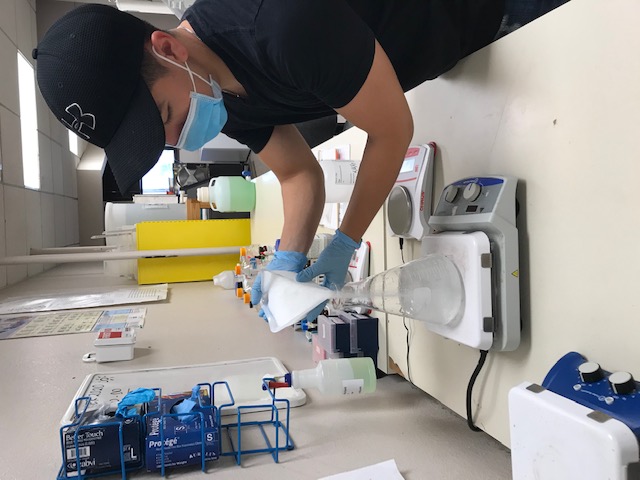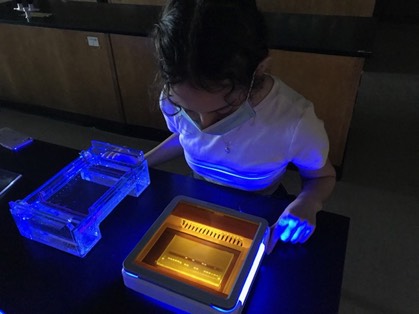UTRGV Team Works to Unravel Venom’s Medicinal Benefits
Tuesday, August 4, 2020
Research
By Maria Elena Hernandez
RIO GRANDE VALLEY, TEXAS – It might be counterintuitive, but snake venom could actually be good for you.
Scientists already are investigating the possible pharmaceutical benefits of snake venom, and research by UTRGV biology lecturer Dr. Ying Jia and two of his undergraduate students could advance those developments.
“Snake venom molecules such as phospholipase A2 can kill some pathogenic bacteria, so venom phospholipase A2 could be used to develop new life-saving antibiotics,” Jia said.
Metalloproteinase is another enzyme found in snake venom.
“Metalloproteinase is the magic toxic protein that can kill some cancer cell lines,” he said. “Many venom molecules could be used for structure-based drug development.”
To understand the exact function of venom toxins at the molecular level, it’s better for researchers to know their three-dimensional structures, and that involves identifying toxin transcripts – generally speaking, messenger RNA, or genetic information, for making toxic venom proteins.

Jia, along with UTRGV senior biology majors Ivan Lopez and Paulina Kowalski, recently published a report in the Journal of Venom Research about their work identifying 14 of the most common toxin transcripts.
“We had identified certain proteins in the crude venom that's found in western diamondbacks,” Lopez said. “There's a wide variety of just certain characteristics that can happen from each protein.”
The trio also predicted the three-dimensional structure of nine venom toxins, which were tested for accuracy and reliability and satisfied quality checks.
“We've always been just, ‘Maybe we could do this and maybe we can do that.’ So we tried to turn that maybe into a real possibility,” Lopez said.
With simulated toxin structures, the researchers can predict how the toxins will interact with other toxins. Fellow UTRGV senior and researcher Kowalski said that structure is key.
“When you get their 3D structure, you can see what parts of it could either inhibit or cause a certain reaction in the body, so it’s really helpful with research for medicinal purposes,” she said.
The venom protein transcripts and their simulated structures also eliminate the need to get venom directly from a snake.
“Once we have these venom protein transcripts, we don't need snake venom anymore, because we can produce venom recombinant proteins by using the tools of biotechnology,” Jia said.


STUDENT SUCCESS
The research report, which was published in June, is just the most recent for Jia, who has spent more than 10 years focusing on using these molecules for medical applications. But it’s the first for Kowalski and Lopez, both UTRGV undergraduates from Brownsville.
“When I got notification from Dr. Jia that it was published, we were all really excited. It's obviously a big deal,” Kowalski said. "Dr. Jia is an amazing mentor. He's extremely knowledgeable in his field, so I'm happy he took Ivan and me under his wing.”
She said Jia introduced them to new software and programs like UCSF ChimeraX, which is used to visualize and analyze molecular structures.
Both students said their families are proud of their work.
“My parents were ecstatic,” Lopez said. “You know, to have support from them was really great. And for them to understand that this is a pretty big accomplishment on my part was just overwhelming."
To learn more about the research underway at the UTRGV Department of Biology, visit utrgv.edu/biology.ABOUT UTRGV
The University of Texas Rio Grande Valley (UTRGV) was created by the Texas Legislature in 2013 as the first major public university of the 21st century in Texas. This transformative initiative provided the opportunity to expand educational opportunities in the Rio Grande Valley, including a new School of Medicine and a School of Podiatry, and made it possible for residents of the region to benefit from the Permanent University Fund – a public endowment contributing support to the University of Texas System and other institutions.
UTRGV has campuses and off-campus research and teaching sites throughout the Rio Grande Valley including Brownsville (formerly The University of Texas at Brownsville campus), Edinburg (formerly The University of Texas-Pan American campus), Harlingen, Weslaco, McAllen, Port Isabel, Rio Grande City and South Padre Island. UTRGV, a comprehensive academic institution, enrolled its first class in the fall of 2015; the School of Medicine welcomed its first class in the summer of 2016, and the School of Podiatric Medicine in the fall of 2022.
